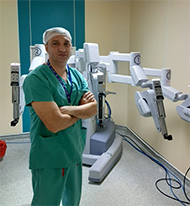Robotic Surgery Center
Ege Robotic Surgery Center is equipped with the "da Vinci Robotic Surgery System" and it is being used by expert surgeons specialized in their own field. This robotic system enables the surgeon to perform surgical procedures with a minimal incision, while benefiting from its advanced three-dimensional imaging and precise movement capabilities.
Cardiovascular surgery, general surgery, gynecology, otorhinolaryngology and urology departments utilize robotic surgery for a variety of procedures ranging from mitral valve prolapse, coronary by-pass surgeries, endocrine surgery, colorectal surgery, obesity surgery, upper gastrointestinal surgery, pancreatic suregry, hernia surgery, hysterectomy to cancer surgeries.
Robotic Surgery in General Surgery:
Endocrine glands surgery (adrenal gland diseases, scarless transoral thyroidectomy, scarless transoral parathyroidectomy), colorectal surgery (colon and rectal cancer, rectal prolapse, Crohn disease, ulcerative colitis, diverticulosis coli),obesity surgery (morbid obesity), donor nephrectomy (kidney transplantation), upper gastrointestinal surgery (gastric cancer, gastric tumor, achalasia, gastroesophageal reflux operation, hiatal hernia), pancreatic resection, cholecystectomy (gallstones), abdominal hernia repair.
Robotic Surgery in Cardiovascular Surgery:
Robotic Surgery in Urology:
In the past 15 years, after the approval of the da Vinci robotic surgery system (Intuitive Surgical, Sunnyvale, CA, USA) by the Food and Drug Administration, robotic surgery has become widespread worldwide. The image obtained with the dual 3-chip camera in robotic surgery provides an enlarged (10-12X) 3-dimensional image and gives a clearer perception than conventional laparoscopic 3-dimensional systems. Robotic instruments equipped with EndoWrist technology have greatly improved the ability to maneuver and suture within the body. In this way, it is possible to move more comfortably in the hard-to-reach areas of the body compared to conventional laparoscopy. This provides an important advantage especially in surgeries requiring intensive reconstruction.
 |
Assoc. Prof. Dr. Adnan ŞİMŞİR E-Mail: adnan.simsir@ege.edu.tr Phone: +90 232 390 25 17
Adnan ŞİMŞİR completed his medical education in Ege University Faculty of Medicine in 1998. Between 2000-2005, he specialized in Urology at Ege University Department of Urology. In 2013, he received the title of Associate Professor at Ege University Faculty of Medicine. After his specialty education, he continued his vocational education by participating in many different educations, courses and congresses. He took courses and educations on endourology courses, PNL - RIRS (closed kidney stone surgeries), pelvic organ prolapse, urinary incontinence, and robotic surgeries.
He continues to serve as the Chairman of the Turkish Continence Association Izmir Branch and member of the Turkish Continence Association Board of Directors. He is a member of Urological Surgery Association, Turkish Urology Association, European Urology Association, International Continence Society (ICS) Association. More than 200 scientific articles have been published in domestic and foreign scientific journals. Assoc. Prof. Dr. Adnan Şimşir is married and has one child.
|
Robotic Surgery in Gynecologic Oncology:
Robotic Surgery in Otorhinolaryngology:










